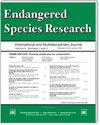Population genetics of gharial Gavialis gangeticus in the Chambal River, India, using novel polymorphic microsatellite markers
IF 2.9
2区 环境科学与生态学
Q2 BIODIVERSITY CONSERVATION
引用次数: 0
Abstract
ABSTRACT: The gharial Gavialis gangeticus is a Critically Endangered crocodylian endemic to the Indian subcontinent. The species has experienced a 95% population decline over the past 2 centuries. The largest self-sustaining population inhabits the protected National Chambal Sanctuary (NCS) in north India and represents >80% of extant gharials globally. We developed de novo a panel of polymorphic gharial-specific microsatellites, using whole genome information and microsatellite search tools. These 15 new markers have multiple numbers of polymorphic alleles that are more informative than those obtained from previous studies. Analyses of 93 scute samples collected across age classes from wild gharials residing in the NCS facilitated accurate assessments of genetic diversity and inbreeding coefficient and identified a historical bottleneck event. Estimates of the observed and expected heterozygosities were lower than those reported earlier. The inbreeding coefficient was low, and the population did not deviate significantly from Hardy-Weinberg equilibrium. The calculated M ratio and 2 heterozygosity tests detected a genetic bottleneck, which is consistent with historic sharp declines in population size, followed by recent recovery. These new gharial microsatellite markers are statistically robust and provide an improved means to assess the population genetics of the largest self-sustaining wild gharial population. This study will facilitate additional investigations on the genetic diversity of other extant gharial populations—not only the few remaining wild populations but also those in zoos and rearing facilities. Additional genetic studies of gharial in the NCS are warranted to inform management strategies.利用新型多态微卫星标记研究印度 Chambal 河 gharial Gavialis gangeticus 的种群遗传学
ABSTRACT: gharialis gangeticus是印度次大陆特有的一种极度濒危的鳄鱼。在过去的两个世纪中,该物种的数量下降了 95%。最大的自我维持种群栖息在印度北部受保护的国家尚巴尔保护区(NCS),占全球现存嘎里亚蛇的80%。我们利用全基因组信息和微卫星搜索工具,从新开发了一个多态长臂猿特异性微卫星小组。这 15 个新标记具有多个多态等位基因,比以往研究获得的标记信息量更大。对从居住在国家保护区的野生长臂猿身上采集的 93 个不同年龄段的鳞片样本进行分析,有助于准确评估遗传多样性和近交系数,并确定了一个历史性瓶颈事件。对观察到的和预期的杂合性的估计低于之前的报告。近交系数较低,种群没有明显偏离哈代-温伯格平衡。计算出的 M 比率和 2 个杂合度测试检测出了遗传瓶颈,这与历史上种群数量急剧下降后最近又恢复的情况一致。这些新的长尾鳕微卫星标记在统计学上是稳健的,为评估最大的自我维持野生长尾鳕种群的种群遗传学提供了一种更好的方法。这项研究将有助于进一步调查其他现存豚鼠种群的遗传多样性,不仅包括仅存的几个野生种群,还包括动物园和饲养设施中的豚鼠种群。有必要对非华南地区的长臂猿进行更多的遗传研究,以便为管理策略提供依据。
本文章由计算机程序翻译,如有差异,请以英文原文为准。
求助全文
约1分钟内获得全文
求助全文
来源期刊

Endangered Species Research
BIODIVERSITY CONSERVATION-
CiteScore
5.50
自引率
6.50%
发文量
38
审稿时长
31 weeks
期刊介绍:
ESR is international and interdisciplinary. It covers all endangered forms of life on Earth, the threats faced by species and their habitats and the necessary steps that must be undertaken to ensure their conservation. ESR publishes high quality contributions reporting research on all species (and habitats) of conservation concern, whether they be classified as Near Threatened or Threatened (Endangered or Vulnerable) by the International Union for the Conservation of Nature and Natural Resources (IUCN) or highlighted as part of national or regional conservation strategies. Submissions on all aspects of conservation science are welcome.
 求助内容:
求助内容: 应助结果提醒方式:
应助结果提醒方式:


